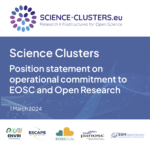Interview with PaNOSC coordinator, Andy Götz, on PaNOSC contribution to the EOSC
We interviewed Andy Götz, PaNOSC coordinator and Head of the Software Group at the European Synchrotron Radiation Facility (ESRF) in Grenoble, on the contribution that PaNOSC will bring to the construction of the EOSC.
Watch the full interview:
Putting PaNOSC into context, Götz started by reminding that photon and neutron sources are used by scientists from disciplines spanning hard condensed matter science, applied material science, engineering, chemistry, soft condensed matter science, life sciences, structural biology, medicine, earth and science, environment, cultural heritage, and more.
Every year, these research infrastructures produce petabytes of data, and the amount will increase as technological upgrades are implemented. In addition, only individuals or small groups currently exploit such data, which are not yet made open access.
The recent implementation of open data policies in some PaN sources, such as ILL, ESRF, EuXFEL, has started to change this trend. Masses of data produced at these sites will soon be openly accessible, and the EOSC is an excellent opportunity to make these open data available to a much larger community.
PaNOSC goal is to make Open Science a reality for Photon and Neutron Sources by implementing FAIR Data Catalogues, enhancing and collecting metadata including e-logbooks, implementing services for Data Analysis, Experiment and Data Simulation and FAIR data training material.
The challenge is to bring new European research infrastructures (ELI, ESS, CERIC-ERIC, ESRF, ILL) up to the same level of implementing best practices of Open Science. “The challenge is technical (software development), scientific (defining metadata, training scientists), financial (human and IT resources are required) and cultural (adopting new practices in our institutes, convincing scientists to change their habits, training new scientists to adopt modern research methods)” states Götz, and continues: “The EOSC can help us address most of these challenges for European and national Photon and Neutron sources. In addition, the EOSC is an excellent motivation for boosting the adoption of FAIR data practices amongst our users”.
In Götz’s view, the EOSC will boost the implementation of Open Data and the necessary data services for promoting inter-disciplinary research between scientists in these areas. Datasets will be findable thereby making them easier to be compared, understood, and re-used to create new publications.
To the questions on which service PaNOSC will bring to the EOSC, Andy Götz listed the major contributions of the project: an enhanced Jupyter notebooks’ service with improved graphical display opportunities, a common API for searching for data, metadata standards for the PaN community, a Data Analysis As a Service (DAAS) portal, simulation software services for photon and neutron data, an e-learning platform and training material for users of PaN sources.
All communities using Jupyter notebooks can profit from this, and all scientists and users of PaN sources can profit from the services provided by PaNOSC. PaNOSC is working closely with the ExPaNDS project, an INFRAEOSC-03 project made up of national photon and neutron sources in Europe, to ensure that ExPaNDS can profit from the outcomes of PaNOSC and vice versa.


